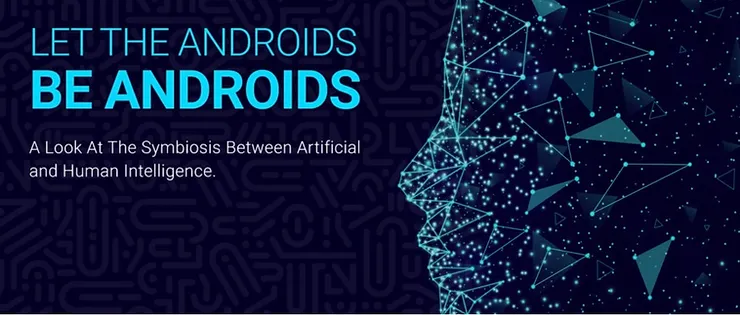Let The Androids Be Androids

We often discuss similarities between Machine Learning (ML) and Human Intelligence. After all, it is “Artificial” intelligence, right? So, why wouldn’t you? To better understand the value of applied ML, you could instead take the opposite approach and look at how ML differs from us humans.
The nature of ML is that it is always learning, always sharing, never forgets, and never leaves for another job. Contrast this with an emotional human. We are not always in the mood to learn. We keep our knowledge close to the vest due to fear of becoming obsolete, we are forgetful and, the grass is always greener on the other side of the fence, so we leave for another job. Eventually. Think about it. Just the cost of poor knowledge sharing is huge. It slows things down further, reduces the quality of output, it is hard to replicate and repeat the process. Then the person leaves and takes all that knowledge with them. This churn adds additional costs in the form of recruiting efforts and even slower execution (after all, you just lost a team member). Fortunately for us, the current state of AI cannot even begin to compete with human intelligence. There are still suitable applications for AI/ML though. Take technology testing for example. Here we deal with repetitive (some would say boring) tasks. This accelerates churn further. It is better to delegate it to a machine and free up us humans work on the fun stuff, like research and development! COLLECT AND KEEP THE INTELLIGENCEThe “always learning” part of ML can create a perception that the ML-based solution is not fully baked. But the solution is fully baked. It is the world around us that is “baking” (changing). Everything evolves, changes, transforms. Even a system under test. To allow ML models to adapt, we allow users to provide feedback to the system. In AI-lingo, it is called reinforcement training. In the past, with rules-based testing software, you would have to modify or add a rule. If you are lucky, that is. Often, you would have to develop and deploy a software upgrade. With an ML-powered solution like B-Yond Agility, the user can provide feedback, which further improves the fidelity of the system. In other words, the tribal knowledge that normally would reside with one single engineer (the user in this example) is now part of the system and shared with everyone. It becomes part of the collective IQ of the ML-supported processes.
Early on in the B-Yond journey, when we applied Artificial Intelligence (AI) to the analysis and root cause phases of testing, we had a hunch that machine learning (ML) was a suitable approach because of two distinct properties: (1) ML can process massive amounts of data and, (2) ML provides detections based on data patterns instead of binary conclusions. While both properties are important, the latter is unique to ML and the driver behind why we have been able to solve the “Two-Third Dilemma” of the technology life cycle. This dilemma is that, while test execution can be automated (the first third), the results analysis and root cause determination (the other two thirds) require a lot of human-like processing. Things are not black-and-white, one test run may not be identical to the next, what we concluded last time only applies partially to the next, and so on. ML deals with patterns and offers a detection with an assessment of a pattern’s resemblance to something that has been seen before. In that regard, ML resembles human thinking. GO FASTERWe believe that solutions, like B-Yond Agility, will ultimately make life better for people by providing a complementary role that was never done well by humans in the first place. Let’s look at this in more detail. Let’s look at how Agility applies ML to Continuous Integration, deployment, testing, and validation (CI/CD, CT/CV – Check out the white paper here).Agility reduces test result validation, failure analysis, and root cause from days to minutes. This reduction in the technology life cycle has profound implications on its own. It eliminates the long pole of go to market for new services and applications. The business benefits are many. Reduced test costs, improved quality, first-mover advantage, accelerated time to revenue, faster feedback on the success of a new feature. The list goes one. Ok, so an ML-powered solution like Agility is faster than a human because of the way AI is different than humans. What else? REDUCING RELIANCE AND CLOSING THE LOOPWith ML applied to CT/CV in production environments, there is tremendous value beyond just accelerating issue triage. You can also reduce your reliance on support from equipment vendors because the ML is now handling the issue triage. Once you gain confidence in the detections, you can begin to automate the operation towards a closed-loop, self-healing system. It sounds like a pipedream, perhaps? It is closer than you think.
If you are interested in learning more, one great way is to schedule a demo. It is easy. Contact us here!


